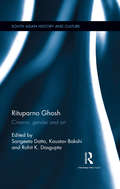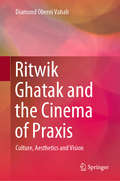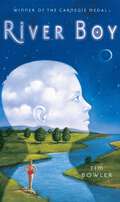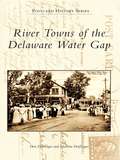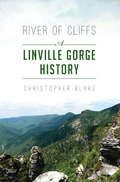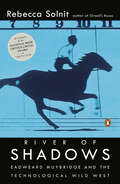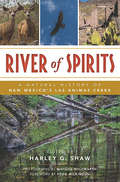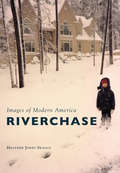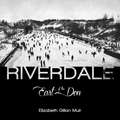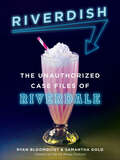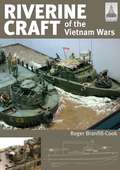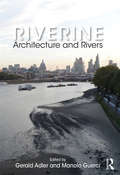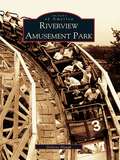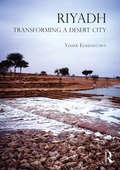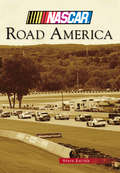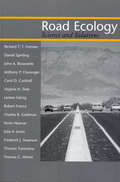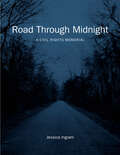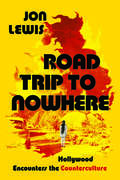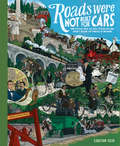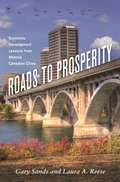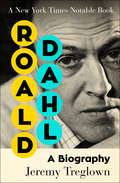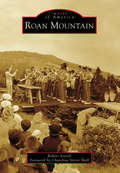- Table View
- List View
Rituparno Ghosh: Cinema, gender and art (South Asian History and Culture)
by Rohit K. Dasgupta Sangeeta Datta Kaustav BakshiAn iconic filmmaker and inheritor of the legendary Satyajit Ray’s legacy, Rituparno Ghosh was one of the finest auteurs to emerge out of contemporary Bengal. His films, though rooted firmly in middle-class values, desires and aspirations, are highly critical of hetero-patriarchal power structures. From the very outset, Ghosh displayed a strong feminist sensibility which later evolved into radical queer politics. This volume analyses his films, his craft, his stardom and his contribution to sexual identity politics. In this first scholarly study undertaken on Rituparno Ghosh, the essays discuss the cultural import of his work within the dynamics of a rapidly evolving film industry in Bengal and more largely the cinematic landscape of India. The anthology also contains a conversation section (interviews with the filmmaker and with industry cast and crew) drawing a critical and personal portrait of this remarkable filmmaker.
Ritwik Ghatak and the Cinema of Praxis: Culture, Aesthetics and Vision
by Diamond Oberoi VahaliIn a significant departure from other works on Ritwik Ghatak, this book establishes him as an auteur and a maestro on par with some of the great film directors, like Sergei Eisenstein, Satyajit Ray, Ingmar Bergman, Federico Fellini, Kenji Mizoguchi and Luis Bunuel. Based on in-depth research that follows Ghatak’s journey within the context of the Indian People’s Theatre Association, it fills an important gap in the scholarship around Ghatak by offering crucial insights into Ghatak’s unique vision of cinema embedded as it is in the cultural psychic configurations of the people. It analyses Ghatak’s practice by minutely tracing formal similarities across the language of his cinematic oeuvre in the domain of cinematography, lighting, music, and sound. The book develops the way in which cinematic technique enters the domain of conceptual constructs and abstractions. It moves on to chronicle Ghatak’s political odyssey as reflected in his cinema. Moreover, it charts the manner in which Ghatak, through his cinematic idiom, offers a polemic of cinema that further adds to his notion of praxis – a thoughtful Marxist paradigm organically associated with the culture and context of India. By locating Ghatak within the discourse of nationalism, the book brings to the surface Ghatak’s critical insights related to the independence of the nation and the trauma of the partition of Bengal. Ghatak’s cinema served the crucial function of chronicling the mass tragedy of partition and its impact on the human psyche.This book appeals to scholars of film studies and filmmaking as well as to researchers and general readers interested in debates pertaining to culture, politics, art, psychoanalysis, partition and refugee studies, cinema, theatre, and ideology.
River Boy
by Tim BowlerShe didn't know how fast the current was moving her. It could take many more hours yet, perhaps more hours than she had the strength for. But she must not stop. She must keep going. She must try to catch the river boy, even though she was frightened at the thought of what he was. Jess's beloved grandfather has just had a serious heart attack, but he insists that the family travel as planned to his boyhood home on the river so that he can finish his painting, River Boy. As Jess helps her ailing grandpa with his work, she becomes entranced by the scene he is painting. Then she becomes aware of a strange presence in the river -- a boy who asks for her help and issues a challenge that will stretch her swimming talents to their very limit. Jess knows that Grandpa and the river boy are connected, but how? Can she take up the river boy's challenge before it's too late for Grandpa? Tim Bowler's gripping narrative flows like a river itself -- gentle and calm at times, turbulent and deep at others, always fluid, always alive. Readers will be swept along by the magic of the river and the mysterious river boy -- and changed forever by Jess's unforgettable journey.
River Towns of the Delaware Water Gap (Postcard History)
by Don Dorflinger Marietta DorflingerAs early as 1829, Antoine Dutot saw potential for a profitable resort industry at the Delaware Water Gap and began construction of the first Kittatinny House overlooking the Delaware River. After the arrival of the Delaware, Lackawanna and Western Railroad in 1856, other hostelries of various sizes and appointments followed and were soon filled each summer with happy vacationers from New York City and Philadelphia. Residents of surrounding villages on both sides of the Delaware River also shared the seasonal wealth of this natural playground, yet they still managed to make a living during the rest of the year. River Towns of the Delaware Water Gap salutes the grand hotels, their diminutive "little sisters," and the people who ran them or lived in the gap and its neighboring river towns.
River Vale (Images of America)
by Edmund A. ModerackiRiver Vale explores a historically rich community that has been known over the years as the Overkill Neighborhood, Harrington Township, Washington Township, and the borough of Eastwood. One of the first settled areas of the Kakiat Patent, River Vale was the scene of the Baylor Massacre, New Jersey's bloodiest skirmish of the Revolutionary War. The area's fine farmland enabled some of Bergen County's earliest settlers to flourish. Strong streams provided power for the mills and the famed Collignon chair factory.By the 1920s, a change came over the township. Its proximity to New York City made River Vale's land more valuable for recreation than for farming, and the township became known for its summer charms, golf courses, and ice arena. Visitors arriving in bus caravans traveled from urban areas to enjoy the pleasures of Herrmann's Grove, and fishermen flocked on opening day to angle for trout in the clear waters of the Hackensack River and the Pascack Brook. It was this very appeal that led to tremendous change as River Vale became one of North Jersey's attractive bedroom communities.
River of Cliffs: A Linville Gorge History
by Christopher BlakeLinville Gorge was the first Wilderness Area on the East Coast, approved by Congress in 1964. “The Grand Canyon of the East” was named for William Linville, a member of a party of long hunters in 1766 who fell victim to a Shawnee attack. The difficult terrain made early settlements nearly impossible and logging unprofitable, and it remains one of the few examples of old-growth forest in the Blue Ridge Mountains. Unique rock formations, from Table Rock to the Chimneys, and miles of trails attract thousands of climbers, hikers and adventure seekers each year. In this revised edition, author Christopher Blake draws on American colonial reports, travel writings, diaries, fiction and numerous archival records to weave a narrative fabric of an American treasure.
River of Offerings
by Jennifer PrughHow does a deeper understanding of the ancient spiritual traditions of India shed new light on our contemporary yoga practice? And what can India&’s River Ganges teach us about how to live in a meaningful way? Through photography and personal narrative, Jennifer Prugh documents a series of pilgrimages over the last ten years to spiritually significant locations along India&’s Ganges River. The Ganges is India&’s most sacred river, winding some 1550 miles from its source, high in the western Himalayas, traveling eastward across the subcontinent to empty out at Sagar Island near Kolkata. The river is also known among Hindus as Mother Ganga, the Goddess. She dissolves sins, drinking her waters cures those who are sick, and dying on her banks ensures freedom from the cycle of life and death. She is a perpetual offering to all who inhabit the Ganges River Valley. What began for the author as simply a trip to India in 2007 to deepen her understanding of her yoga practice became a passionate pursuit to broaden her understanding of the ancient spiritual culture of India, from which modern yoga practice evolved and changed her life. By plane, train, automobile, rickshaw, and on foot, she traveled with camera in tow to many of India&’s sacred destinations along the Ganges, from high in the Himalayas at the river&’s source at Gangotri, to the great Kumbha Mela festival held in Allahabad, to the cremation ghats in Varanasi. Prugh explores the stories from the heroic epics that provide the backbone for contemporary yoga philosophy, as well as the sacred wisdom that animates India&’s spiritual legacy. Part history, part mythology, and part travel narrative, this is a visual and written account of the trials, tribulations, and personal discoveries of an American female yoga practitioner. River of Offerings serves to broaden our understanding of how to live our lives meaningfully, with passion and purpose. A visually compelling and beautiful journey from cover to cover, this book will be a cherished source of inspiration for years to come.
River of Shadows: Eadweard Muybridge And The Technological Wild West
by Rebecca SolnitThe world as we know it today began in California in the late 1800s, and Eadweard Muybridge had a lot to do with it. This striking assertion is at the heart of Rebecca Solnit’s new book, which weaves together biography, history, and fascinating insights into art and technology to create a boldly original portrait of America on the threshold of modernity. The story of Muybridge—who in 1872 succeeded in capturing high-speed motion photographically—becomes a lens for a larger story about the acceleration and industrialization of everyday life. Solnit shows how the peculiar freedoms and opportunities of post–Civil War California led directly to the two industries—Hollywood and Silicon Valley—that have most powerfully defined contemporary society. .
River of Spirits: A Natural History of New Mexico’s Las Animas Creek (Natural History)
by Matilde HolzwarthOriginating high in New Mexico's mysterious Black Range and flowing to the Rio Grande amid contorted, ghost-like sycamores, Las Animas Creek remains one of the least accessible landscapes in the nation. The watershed is best known as the site of Apache chief Victorio's last major battle with the U.S. Cavalry before his retreat and ultimate defeat by the Mexican army. Despite its geographic isolation, the watershed remains closely linked with the history of nearby Kingston, Hillsboro and Caballo. Once home to New Mexico's last grizzly, Las Animas sustains a diverse range of native plants and wild animals, including bison, prairie dogs and mountain lions, as well as a host of endangered species. Aldo Leopold Wilderness and Ted Turner's Ladder Ranch ensure it remains Rio de las Animas, the "River of Spirits." Wildlife research biologist Harley G. Shaw compiles a human and natural history of this remote ecosystem.
Riverchase (Images of Modern America)
by Heather Jones SkaggsIf residents of the original c. 1900s mining town of Acton, Alabama, looked into the future, would they have imagined that the area would develop into the multimillion-dollar planned community it is today? In the late 1960s, John M. Harbert III (1921-1995), founder of Harbert Corporation, saw tremendous potential for land in Acton owned by the Chace brothers. In 1974, the Harbert Corporation partnered with Equitable Life Assurance Society of the United States to form Harbert-Equitable Joint Venture, Riverchase. This plan was not a concrete jungle of homes and businesses. The venture called for a careful blending of new development with its surrounding natural landscape. This plan spoke to man's need to be part of nature, albeit in a new and responsible way. Today, Riverchase is a picturesque community steeped in land preservation, business development, and community pride. The story of Riverchase is conveyed through the memories of its residents in Images of Modern America: Riverchase.
Riverdale: East of the Don
by Elizabeth Gillan MuirHeritage Toronto Book Award — Shortlisted, Non-Fiction Book A popular history of the Riverdale area of Toronto, including Playter Estates north of the Danforth. In its first 50 years, the city of Toronto changed from a rough settlement to a booming city with a voracious appetite for land. The incorporated city of Toronto grew tenfold from 1834 to 1884 — partly through immigration, but also through the annexation of older communities. Among these were the former suburbs of Leslieville and Riverside, which were joined together in 1884 to become the new Toronto community of Riverdale. Later, the Playter Estates neighbourhood also became part of this community. Riverdale tells the history of the neighbourhood, starting with the Simcoe, Scadding, Playter, and Leslie families, who shaped the area throughout its early settlement, the American Revolution, and the War of 1812. It shows the waves of immigration from Britain, America, Italy, Greece, and China, that made Riverdale one of Toronto’s most diverse areas. And it tells the stories written into the map of the neighbourhood, revealing the history on display in its streets and historic buildings.
Riverdish: The Unauthorized Case Files of Riverdale
by Ryan Bloomquist Samantha GoldFrom the hosts of the Riverdish podcast, the unauthorized case files from the world of the CW’s teen drama sensation Riverdale.For Archie Andrews, Veronica Lodge, Jughead Jones, and Betty Cooper, high school is more than just pep rallies and milkshakes. Based on the beloved characters from the Archie Comics, Riverdale is a dark, addictive, campy teen thriller that devilishly mixes adolescent angst with corruption, politics, serial killers, gang wars, and twisted secrets. The emotional exploits of Archie, Veronica, Jughead, Betty, and their friends and foes have riveted fans across generations and catapulted the teen drama series into an iconic cultural phenomenon spawning internet discussion groups and podcasts. One such podcast is Riverdish, hosted by the adoring and enthusiastic Ryan and Sam, and they have taken it upon themselves to complete the complicated and necessary task of creating the essential unauthorized case files on Riverdale's twisted web of lies, crimes and mysteries.Featuring case files on Riverdale’s beloved ensemble cast of Archie, Veronica, Jughead, Betty and their friends and foes, Riverdish offers up comprehensive breakdowns of the many mysteries and crimes that plague the town of Riverdale, paired with laugh-out-loud commentary and photos from behind-the-scenes of the show. Tackling everything from The Black Hood to Jingle Jangle to the Southside Serpents to bogus FBI agents and everything and everyone in between, Riverdish is an insightful and hilarious sendup of the case files that the authorities should use to track the many twists and turns of the show. With a deep knowledge of and appreciation for the show and all that makes it iconic, Riverdish dissects and celebrates the dramatic and thrilling darkness of Riverdale.
Riverine Craft of the Vietnam Wars (ShipCraft #26)
by Roger Branfill-Cook“Provides clear and succinct descriptions of the various craft used not only by American forces but those of the French and South Vietnamese Navy.” —Army Rumour Service (ARRSE)The ShipCraft series provides in-depth information about building and modifying model kits of famous warship types. Lavishly illustrated, each book takes the modeler through a brief history of the subject, highlighting differences between ships and changes in their appearance over their careers. This includes paint schemes and camouflage, featuring color profiles and highly detailed line drawings and scale plans. The modeling section reviews the strengths and weaknesses of available kits, lists commercial accessory sets for super-detailing of the subjects, and provides hints on modifying and improving the basic kit. This is followed by an extensive photographic gallery of selected high-quality models in a variety of scales, and the book concludes with a section on research references—books, monographs, large-scale plans and relevant websites. This volume is something of a departure for the series in covering a wide variety of the types, at first improvised and then purpose-built for the Brown Water conflict. Besides the well-known American involvement, the book also covers some of the craft used by the French in their earlier struggle with Vietnamese guerrillas. With its unparalleled level of visual information—paint schemes, models, line drawings and photographs—this book is simply the best reference for any modelmaker setting out to build one of these unusual craft.“Very well written . . . The author’s interest, knowledge and enthusiasm come through the content and make the title so appealing to the reader.” —Armorama
Riverine: Architecture and Rivers
by Gerald Adler Manolo GuerciRiverscapes are the main arteries of the world’s largest cities, and have, for millennia, been the lifeblood of the urban communities that have developed around them. These human settlements – given life through the space of the local waterscape – soon developed into ritualised spaces that sought to harness the dynamism of the watercourse and create the local architectural landscape. Theorised via a sophisticated understanding of history, space, culture, and ecology, this collection of wonderful and deliberately wide-ranging case studies, from Early Modern Italy to the contemporary Bengal Delta, investigates the culture of human interaction with rivers and the nature of urban topography. Riverine explores the ways in which architecture and urban planning have imbued cultural landscapes with ritual and structural meaning.
Riverview Amusement Park (Images of America)
by Dolores HaughEvery summer from 1904 to 1967, for 63 years, Riverview--the world's largest amusement park--opened its gates to millions of people from all walks of life. For three generations, the Schmidt's family park offered rides, shows, food, and music to men, women, and especially children. Riverview survived depressions, two World Wars, labor disputes, Prohibition, and a World's Fair that threatened to take a great deal of its business. Riverview Amusement Park tells the story of Riverview's growth from 22 acres and three rides to 140 acres and more than 100 attractions. Through an extensive collection of never-before published images, author Dolores Haugh chronicles the tale of this impressive chapter of Chicago history. Known as the "Roller Coaster Capital of America," Riverview remained a Chicago landmark until it was unexpectedly closed in 1967.
Riyadh: Transforming a Desert City (Planning, History and Environment Series)
by Yasser ElsheshtawyRiyadh has set its sights on becoming a world city befitting the twenty-first century. To that end it has embarked on a massive construction drive evidenced in the proliferation of proposals for high-end districts, giga-developments and elaborate infrastructures. An urban vision seemingly dedicated to attracting global capital. Yet such a narrative can be misleading. A ‘humanization programme’, initiated during the tenure of its former mayor Abdulaziz bin Ayyaf, has complemented the city’s rapid rise by providing spaces catering for the everyday needs of its inhabitants. Yasser Elsheshtawy, in this richly illustrated book, targets these people-centred settings. It is a compelling counter-narrative interweaving critical theoretical insights, personal observations, and serendipitous encounters. He deftly demonstrates how Riyadh thrives through the actions of its people. As the world moves towards an urban model that is resilient and humane, the humanizing efforts of an Arab city are worthy of our attention. Riyadh’s premise is perhaps best captured in the cover image depicting the desert riverbed of Wadi Sulai, filled with rainwater, making its way towards the Saudi capital. Along its banks there will be dedicated public pathways and urban parks. It is a vision of an urbanity where both the spectacular and the everyday coexist. A city that is not just dedicated to the few, but one that serves the many.
Road America
by Steve ZautkeLocated one hour north of Milwaukee in Wisconsin's scenic Kettle Moraine, Elkhart Lake's Road America race course is one of the world's most famous permanent road racing tracks. Dating back to 1955, the scenic race course has seen the finest in motorsports, such as NASCAR, open wheel, and sports cars, and the best in amateur racing. The track also hosts year-round activities for corporate outings, go-karting, motorcycle/driving schools, and even paintball.
Road Ecology: Science and Solutions
by Virginia H. Dale Daniel Sperling Anthony P. Clevenger Richard T.T. Forman Carol D. Cutshall John A. BissonetteA central goal of transportation is the delivery of safe and efficient services with minimal environmental impact. In practice, though, human mobility has flourished while nature has suffered. Awareness of the environmental impacts of roads is increasing, yet information remains scarce for those interested in studying, understanding, or minimizing the ecological effects of roads and vehicles. Road Ecology addresses that shortcoming by elevating previously localized and fragmented knowledge into a broad and inclusive framework for understanding and developing solutions. The book brings together fourteen leading ecologists and transportation experts to articulate state-of-the-science road ecology principles, and presents specific examples that demonstrate the application of those principles. Diverse theories, concepts, and models in the new field of road ecology are integrated to establish a coherent framework for transportation policy, planning, and projects. Topics examined include: *foundations of road ecology *roads, vehicles, and transportation planning *vegetation and roadsides *wildlife populations and mitigation *water, sediment, and chemical flows *aquatic ecosystems *wind, noise, and atmospheric effects *road networks and landscape fragmentationRoad Ecology links ecological theories and concepts with transportation planning, engineering, and travel behavior. With more than 100 illustrations and examples from around the world, it is an indispensable and pioneering work for anyone involved with transportation, including practitioners and planners in state and province transportation departments, federal agencies, and nongovernmental organizations. The book also opens up an important new research frontier for ecologists.
Road Through Midnight: A Civil Rights Memorial (Documentary Arts and Culture, Published in association with the Center for Documentary Studies at Duke University)
by Jessica IngramAt first glance, Jessica Ingram's landscape photographs could have been made nearly anywhere in the American South: a fenced-in backyard, a dirt road lined by overgrowth, a field grooved with muddy tire prints. These seemingly ordinary places, however, were the sites of pivotal events during the civil rights era, though often there is not a plaque with dates and names to mark their importance. Many of these places are where the bodies of activists, mill workers, store owners, sharecroppers, children and teenagers were murdered or found, victims of racist violence. Images of these places are interspersed with oral histories from victims' families and investigative journalists, as well as pages from newspapers and FBI files and other ephemera.With Road Through Midnight, the result of nearly a decade of research and fieldwork, Ingram unlocks powerful and complex histories to reframe these commonplace landscapes as sites of both remembrance and resistance and transforms the way we regard both what has happened and what's happening now—as the fight for civil rights goes on and memorialization has become the literal subject of contested cultural and societal ground.
Road Trip to Nowhere: Hollywood Encounters the Counterculture
by Jon LewisHow a new generation of counterculture talent changed the landscape of Hollywood, the film industry, and celebrity culture. By 1967, the commercial and political impact on Hollywood of the sixties counterculture had become impossible to ignore. The studios were in bad shape, still contending with a generation-long box office slump and struggling to get young people into the habit of going to the movies. Road Trip to Nowhere examines a ten-year span (from 1967 to 1976) rife with uneasy encounters between artists caught up in the counterculture and a corporate establishment still clinging to a studio system on the brink of collapse. Out of this tumultuous period many among the young and talented walked away from celebrity, turning down the best job Hollywood—and America—had on offer: movie star. Road Trip to Nowhere elaborates a primary-sourced history of movie production culture, examining the lives of a number of talented actors who got wrapped up in the politics and lifestyles of the counterculture. Thoroughly put off by celebrity culture, actors like Dennis Hopper, Christopher Jones, Jean Seberg, and others rejected the aspirational backstory and inevitable material trappings of success, much to the chagrin of the studios and directors who backed them. In Road Trip to Nowhere, film historian Jon Lewis details dramatic encounters on movie sets and in corporate boardrooms, on the job and on the streets, and in doing so offers an entertaining and rigorous historical account of an out-of-touch Hollywood establishment and the counterculture workforce they would never come to understand.
Roadmap to Sustainable Textiles and Clothing
by Subramanian Senthilkannan MuthuThis book covers the elements involved in achieving sustainability in textiles and clothing sector. The chapters covered in three volumes of this series title cover all the distinctive areas earmarked for achieving sustainable development in textiles and clothing industry. This third volume highlights the areas pertaining to the regulatory aspects and sustainability standards applicable to textiles and clothing supply chain. There are various standards earmarked for measuring the environmental impacts and sustainability of textile products. There are also plenty of certification schemes available along with the index systems applicable to textile sector. Brands and manufactures are also venturing into new developments to achieve sustainable development in textile sector. This third volume addresses all these important aspects.
Roads Were Not Built for Cars: How cyclists were the first to push for good roads & became the pioneers of motoring
by Carlton ReidIn Roads Were Not Built for Cars, Carlton Reid reveals the pivotal--and largely unrecognized--role that bicyclists played in the development of modern roadways. Reid introduces readers to cycling personalities, such as Henry Ford, and the cycling advocacy groups that influenced early road improvements, literally paving the way for the motor car. When the bicycle morphed from the vehicle of rich transport progressives in the 1890s to the "poor man's transport" in the 1920s, some cyclists became ardent motorists and were all too happy to forget their cycling roots. But, Reid explains, many motor pioneers continued cycling, celebrating the shared links between transport modes that are now seen as worlds apart. In this engaging and meticulously researched book, Carlton Reid encourages us all to celebrate those links once again.
Roads to Prosperity: Economic Development Lessons from Midsize Canadian Cities
by Gary Sands Laura A. ReeseRoads to Prosperity: Economic Development Lessons from Midsize Canadian Cities explores the relative prosperity of midsize Canadian urban areas (population 50,000 to 400,000) over the past two decades. Communities throughout North America have strived for decades to maintain and enhance the prosperity of their residents. In the areas that are the focus of this research, the results of these efforts have been mixed—some communities have been relatively successful while others have fallen further behind the national averages. Midsize cities often lack the resources, both internal and external, to sustain and enhance their prosperity. Policies and strategies that have been successful in larger urban areas may be less effective (or unaffordable) in smaller ones. Roads to Prosperity first examines the economic structure of forty-two Canadian urban regions that fall within the midsize range to determine the economic specializations that characterize these communities and to trace how these specializations have evolved over the time period between 1991 and 2011. While urban areas with an economic base of natural resource or manufacturing industries tend to retain this economic function over the years, communities that rely on the service industries have been much more likely to experience some degree of restructuring in their economies over the past twenty years. The overall trend among these communities has been for their employment profiles to become more similar and for their economic specialization to fade over time. The second part of the book looks at a number of currently popular economic development strategies as they have been applied to midsize urban areas and their success and failures. While there appears to be no single economic development strategy that will lead to greater prosperity for every community, Sands and Reese explore the various factors that help eplain why some work and others don’t. Those with an interest in urban planning and community development will find this monograph highly informative.
Roald Dahl: A Biography
by Jeremy TreglownA New York Times Notable Book: A revealing look at the famous twentieth-century children&’s author who brought us The BFG and Charlie and the Chocolate Factory. Few writers have had the enduring cultural influence of Roald Dahl, who inspired generations of loyal readers. Acclaimed biographer Jeremy Treglown cuts no corners in humanizing this longstanding immortal of juvenile fiction. Roald Dahl explores this master of children&’s literature from childhood—focusing a tight lens on the relationship between Dahl and his mother, who lovingly referred to him as &“Apple&”—through to his death. Treglown deftly navigates Dahl&’s time as a fighter pilot in the Royal Air Force, exploring how the experience transformed many of the beliefs that influenced the English writer&’s work, including The Gremlins, which was commissioned by Walt Disney. A former editor of the Times Literary Supplement, Treglown discusses many of Dahl&’s most famous works, such as James and the Giant Peach and Fantastic Mr. Fox, while also delving into his marriage to actress Patricia Neal, combing through letters and archives to show a man who could be both comic and vitriolic, thoughtful yet manipulative and irascible. Treglown highlights many of Dahl&’s literary achievements as well as his breakdowns and shortcomings, presenting a very personal and telling picture of the author and the inner turmoil that crippled him. Separating the man from the myth, Treglown&’s frank, intimate portrait of Dahl illuminates the contradictions within the mind of this beloved author, a man who could be both a monster and a hero. It is required reading for book lovers and film buffs alike.
Roan Mountain (Images of America)
by Robert Sorrell Chandrea ShellRoan Mountain, a 6,286-foot-high peak, straddles the Tennessee and North Carolina state line in the Appalachian Mountains. Home to world-famous rhododendron gardens, the Appalachian Trail, the site of Gen. John T. Wilder's historic Cloudland Hotel, and record-breaking lofty balds, thousands of visitors, including explorer John Muir and Vice Pres. Richard Nixon, have ascended Roan Mountain over the last two centuries. Biologists, botanists, and tourists have enjoyed its unique natural setting. At the mountain's base and on its slopes, rural communities have endearing histories. Decades ago, the East Tennessee and Western North Carolina Railroad passed through the village at the foot of "the Roan." The railroad brought wealthy passengers to the mountain-top Cloudland Hotel. It also allowed local industrialists the opportunity to export the area's natural resources. The people of Roan Mountain are proud of their history and have displayed it annually for more than a half-century during the Rhododendron Festival.
